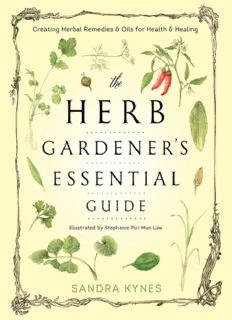
The herb gardener's essential guide: creating herbal remedies and oils for health & healing PDF
Preview The herb gardener's essential guide: creating herbal remedies and oils for health & healing
About the Author Sandra Kynes is a yoga instructor, a Reiki practitioner, and a member of the Bards, Ovates and Druids. She likes developing creative ways to explore the world and integrating them with her spiritual path, which serves as the basis for her books. She has lived in New York City, Europe, England, and now © Jessica Weiser coastal New England. She loves connecting with nature through gardening, hiking, and ocean kayaking. Visit her website at www.kynes.net. Llewellyn Publications Woodbury, Minnesota Acknowledgements My thanks to Amy Glaser whose vision started this book, Stephanie Pui-Mun Law for her beautiful artwork, and Lynne Menturweck for her direction in pulling it all together; Liz Parsons and Rosanne Graef for inviting me to join our neighborhood apothecary garden project; and my family Lyle Koehnlein and Jessica Weiser who share a small oasis of a backyard garden with me. Contents INTRODUCTION Part 1: Creating an Apothecary Garden C 1: A History of HAPTER Herbal Medicine C 2: Garden Design Past and Present C HAPTER HAPTER 3: Choosing Your Plants C 4: Bugs and Birds C 5: Tools HAPTER HAPTER and Personal Gear C 6: Let’s Get Going C 7: Preparing HAPTER HAPTER the Soil and Planting C 8: Maintaining Your Garden C HAPTER HAPTER 9: Window and Porch Gardens Part 2: Preparing Herbs for Storage and Making Herbal Remedies C 10: Harvesting the Bounty of HAPTER Your Garden C 11: After the Harvest C 12: Essential HAPTER HAPTER and Carrier Oil Basics C 13: Making Your Own Herbal HAPTER Remedies C 14: Other Forms of Remedies C 15: HAPTER HAPTER Culinary Uses of Herbs for Good Health Part 3: Herb Profiles Angelica Anise Basil Bay Borage Caraway Cayenne The Chamomiles Clary Coriander/Cilantro Dill Fennel Garlic Hyssop Lavender Lemon Balm Lemongrass Marjoram The Mints Parsley Peppermint Rosemary The Sages St. John’s Wort Spearmint Thyme Valerian Yarrow CONCLUSION APPENDIX A: Herbs for Ailments, Conditions, and Support for Good Health APPENDIX B: Measurement Equivalents GLOSSARY BIBLIOGRAPHY Disclaimer This book is not intended to provide medical advice or to take the place of medical advice and treatment from your personal physician. Readers are advised to consult their doctors or other qualified healthcare professionals regarding the treatment of their medical problems. Neither the publisher nor the author take any responsibility for any possible consequences from any treatment, action, or application of medicine, supplement, herb, or preparation to any person reading or following the information in this book. INTRODUCTION T here is a special beauty to herbs. We may know many of them as unassuming garden plants, but their use is intertwined with human history. For thousands of years they have provided people with fragrance, taste, and healing. My interest in herbs has affected several aspects of my life—cooking, gardening, and the desire for natural healing—which has led to an interest in essential oils. Before going further, I must explain that I am not a trained herbalist nor am I certified through any program or school. I am like the many thousands throughout the ages who have gone before me to learn from others, observe, and study on my own. I grew up in a household where the first line of defense against illness or discomfort and the first aid rendered after injury came from the kitchen or my grandmother’s garden. While commercial products eventually made their way into the medicine cabinet (“new” and “convenient” were the buzzwords of the early 1960s), my mother often drifted back to remedies she knew as a child. Because of that, I became familiar with them, too. However, while I consider herbs comforting, my preference for herbal remedies goes beyond childhood memories. Like many people today, I think nature offers a better way of dealing with common, basic health issues, and I prefer not to use medicines made from synthetic chemicals. As I mentioned, I am not an expert. I work with herbs and essential oils for my own purposes and not to provide treatment to other people or sell products. While it may seem odd that I have written a book on herbs and essential oils, my purpose is to encourage others to explore the healthful bounty of the plant kingdom without feeling intimidated. After all, our ancestors were not “herbologists,” they simply used the knowledge that was handed down through generations and did what they needed to do to relieve discomfort and stay healthy. That said, we must keep in mind that herbs are powerful and they must be used properly. Like many books about herbs and healing remedies, details on how to grow and prepare them for use is also included here. However, I have veered onto my own path by integrating information on essential oils. After all, the history of essential oils is intertwined with that of herbal medicine. While essential oils require a great deal of plant material and few of us have the space to grow enough or the equipment to distill it, I have included them because they expand and enhance our herbal repertoire.
Description: